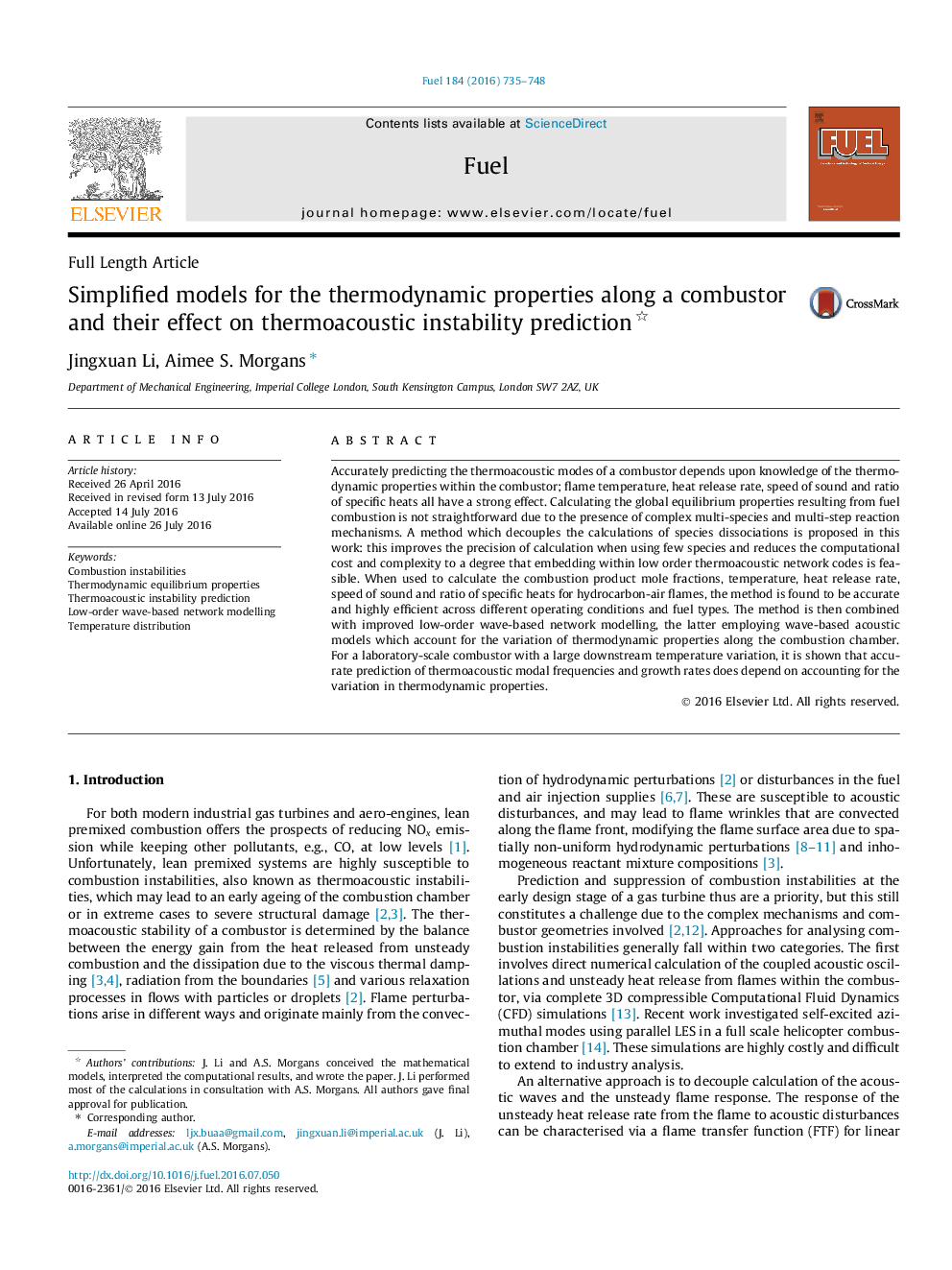| کد مقاله | کد نشریه | سال انتشار | مقاله انگلیسی | نسخه تمام متن |
|---|---|---|---|---|
| 6633139 | 461089 | 2016 | 14 صفحه PDF | دانلود رایگان |
عنوان انگلیسی مقاله ISI
Simplified models for the thermodynamic properties along a combustor and their effect on thermoacoustic instability prediction
ترجمه فارسی عنوان
مدل های ساده برای خواص ترمودینامیکی در امتداد یک آتش سوزی و تأثیر آن بر پیش بینی بی ثباتی گرماکواسیک
دانلود مقاله + سفارش ترجمه
دانلود مقاله ISI انگلیسی
رایگان برای ایرانیان
کلمات کلیدی
ناپایداری احتراق، خواص تعادل ترمودینامیکی، پیش بینی بی ثباتی حرارتی، مدل سازی شبکه مبتنی بر موج پایین با فرکانس پایین، توزیع دما،
ترجمه چکیده
دقیقا پیش بینی حالت گرماسوختی یک آتش سوزی بستگی به دانستن خواص ترمودینامیکی داخل آتش سوزی دارد؛ دمای شعله، سرعت آزاد شدن گرما، سرعت صدا و نسبت گرمای خاص، اثر بسیار زیادی دارند. محاسبه خواص تعادل جهانی ناشی از احتراق سوخت به دلیل حضور چند سازه پیچیده و چند مرحله ای واضح نیست. روشی که محاسبات مربوط به گونه ها را جدا می کند، در این کار پیشنهاد می شود: این دقت محاسبات را هنگام استفاده از چند گونه بهبود می بخشد و هزینه و پیچیدگی محاسبات را تا درجه ای کاهش می دهد که امکان تعمیر در کد های شبکه ترموآکوستیکی کمینه امکان پذیر است. هنگامی که برای محاسبه مولکولهای محصولات احتراق، درجه حرارت، سرعت آزاد شدن حرارت، سرعت صدا و نسبت گرمای خاص برای شعله های هیدروکربن هوا استفاده می شود، این روش دقیق و بسیار کارآمد در شرایط عملیاتی مختلف و انواع سوخت است. این روش سپس با مدلسازی شبکهای مبتنی بر موج بهبود یافته کم نظیر ترکیب شده است؛ دوم، مدلهای آکوستیک مبتنی بر موج را که موجب تغییرات خواص ترمودینامیکی در امتداد اتاق احتراق می شود، به کار می برند. برای یک آتش سوزی در مقیاس آزمایشگاهی با تغییرات دما در پایین جریان، نشان داده شده است که پیش بینی دقیق فرکانس های مودال حرارتی و سرعت رشد به حساب آوردن تغییرات خواص ترمودینامیکی بستگی دارد.
موضوعات مرتبط
مهندسی و علوم پایه
مهندسی شیمی
مهندسی شیمی (عمومی)
چکیده انگلیسی
Accurately predicting the thermoacoustic modes of a combustor depends upon knowledge of the thermodynamic properties within the combustor; flame temperature, heat release rate, speed of sound and ratio of specific heats all have a strong effect. Calculating the global equilibrium properties resulting from fuel combustion is not straightforward due to the presence of complex multi-species and multi-step reaction mechanisms. A method which decouples the calculations of species dissociations is proposed in this work: this improves the precision of calculation when using few species and reduces the computational cost and complexity to a degree that embedding within low order thermoacoustic network codes is feasible. When used to calculate the combustion product mole fractions, temperature, heat release rate, speed of sound and ratio of specific heats for hydrocarbon-air flames, the method is found to be accurate and highly efficient across different operating conditions and fuel types. The method is then combined with improved low-order wave-based network modelling, the latter employing wave-based acoustic models which account for the variation of thermodynamic properties along the combustion chamber. For a laboratory-scale combustor with a large downstream temperature variation, it is shown that accurate prediction of thermoacoustic modal frequencies and growth rates does depend on accounting for the variation in thermodynamic properties.
ناشر
Database: Elsevier - ScienceDirect (ساینس دایرکت)
Journal: Fuel - Volume 184, 15 November 2016, Pages 735-748
Journal: Fuel - Volume 184, 15 November 2016, Pages 735-748
نویسندگان
Jingxuan Li, Aimee S. Morgans,
